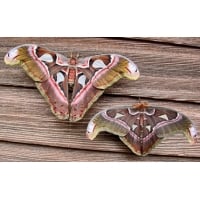Search
Search CriteriaSearch:
Products meeting the search criteria
Giant Atlas Moth Attacus atlas
Atlas cocoons have become very difficult to obtain, particularly the dormant Thailand race, but we expect to have them again this winter.
The largest moth in the world. Winter cocoons are dormant. You can choose whether to incubate them or keep them cold until the spring. To get them to emerge, raise the temperature to 15 degrees C, and gradually up to 30 degrees C or more, and very humid. They need very warm and humid tropical conditions. When hot, soak the cocoons at least once or twice daily.
It is probably better to keep them cool (8 -12 degrees C) and dormant until mid-April, or even May, then raise the temperature and humidity as described above. They will respond better to summer conditions.
Pairing is achieved in a cage that is ample for the size of the moths but not so large that they can become too separated.
Larvae feed on Privet Ligustrum and are easily reared in warm and moist conditions. Atlas larvae will also feed on Tree of Heaven Ailanthus, Osier Willow Salix viminalis, Citrus and undoubtedly a number of other substitute plants outside their normal habitat.
Giant Atlas Moth Attacus atlas
One of the largest of all moth species in the world! The larvae feed well on Privet, at any time of the year, and might accept Portuguese Laurel. They require very clean conditions, always with fresh food. Alternative recorded foodplants include Willows, Lilac, Apple, Plum, Ash, Cherry and Tree of Heaven Ailanthus. Atlas larvae like to browse on several foodplants and settle for the one or more that they like.
The larvae like warmth 25 -30 degrees C and humid jungle conditions, which are best achieved in a tank or plastic container, rather than a netting cage. Given these conditions the larvae are not difficult to rear, and spin cocoons in about 8 weeks from hatching.
Attacus lorquinii - Philippines
This species, endemic to the Philippines, is characterised by the prominent red lines and markings across the wings.
You can choose whether to incubate them or keep them cold until the spring. To get them to emerge, raise the temperature to 15 degrees C, and gradually up to 30 degrees C or more, and very humid. They need very warm and humid tropical conditions. When hot, soak the cocoons at least once or twice daily.
It is probably better to keep them cool (8 -12 degrees C) and dormant until mid-April, or even May, then raise the temperature and humidity as described above. They will respond better to summer conditions.
Pairing is achieved in a cage that is ample for the size of the moths but not so large that they can become too separated.The larvae feed on Privet. They appreciate humidity and a temperature of at least 25 degrees C.



